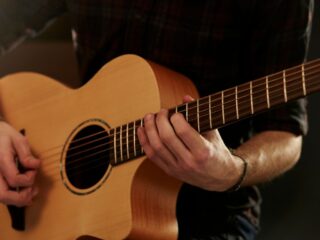
Chord Sancang, it’s a term that might sound unfamiliar to many, but to music enthusiasts, it’s a fascinating topic. This unique musical concept, originating from Indonesia, has been captivating the hearts of many music lovers around the globe.
The beauty of Chord Sancang lies in its simplicity and versatility. It’s a melody that can be played on various instruments, making it a favorite among musicians of all levels. Whether you’re a beginner just starting your musical journey, or an experienced player looking for a new challenge, Chord Sancang has something to offer.
In the world of music, where creativity and expression are key, Chord Sancang stands out as a testament to the power of simple melodies. It’s not just a chord progression, but a cultural heritage that continues to inspire musicians worldwide.
Chord Sancang
Emerging from the rich cultural milieu of Indonesia, Chord Sancang stands as a testament to the country’s dynamic musical traditions. This musical concept embodies a unique blend of simplicity, versatility, and challenge. It’s an element of appeal that lies in its nuance and depth – easy enough for beginners to grasp, yet offering layers of complexity for more experienced musicians to explore.
Distinctive in its structure and form, Chord Sancang isn’t just a sequence of notes played together. It’s a representation of beautiful harmonies woven together to create a captivating sonic tapestry. Often employed in traditional Indonesian music genres, the innate charm and flexibility of this chord progression have transcended geographical boundaries. Today, it’s widely adopted by musicians and composers across the globe.
The potency of Chord Sancang lies in its ability to cater to different musical tastes and styles. Whether it’s jazz, pop, or classical compositions, this diverse chord progression enriches the musical repertoire, leading to more vibrant, engaging pieces. Its embrace by the global music community underlines the widespread recognition for Indonesia’s unique musical heritage.
Another compelling aspect of Chord Sancang is the way it provokes creativity within musicians. Sure, there are rules to follow in its application, but these guidelines serve more like gateways to endless possibilities in music creation. It challenges musicians to stretch their musical thinking, explore their artistic boundaries, and engage in a deeper, more profound musical journey. Chord Sancang doesn’t merely exist as a part of music – it’s indeed a way to rethink music itself.
History of Chord Sancang

Chord Sancang emerged from the heart of Indonesia. Its roots are embedded within the rich and diverse musical landscapes of the archipelago. It is a product of the cultural melting pot influenced by indigenous music genres and increasingly global musical influences. It’s a unique blend that distinguishes it from other musical concepts, creating a distinct sound that reverberates with a charm that’s distinctly Indonesian.
While its exact inception remains shrouded in time’s haze, its influences hint towards an amalgamation of traditional Indonesian music, jazz, and bepop genres.
Evolution over Time
The progression of Chord Sancang has been an adventure in itself, challenging and molding the boundaries of Indonesian music. Through decades, it has bloomed and developed, nurturing an intriguing fusion of styles. Its evolution echoes the dynamic progression of music itself; dynamic, unpredictable, yet harmonious.
Initially influenced primarily by jazz and bepop, Chord Sancang expanded to incorporate elements from pop and classical music genres. It becomes a versatile sonic tool, embraced and experimented across musical landscapes. Transformative and adaptable, it has carved an essential place in the global music sector.
The chord progression’s initial simplicity eventually evolved into a multifaceted tool that enables endless possibilities. Its transition unfolded through various musical genres adapting and employing it differently, demonstrating its vibrancy and adaptability. Consequently, Chord Sancang’s influence reverberated globally, leaving its distinct mark in various compositions, from pop charts to symphony orchestras.
Significance of Chord Sancang
Chord Sancang holds an elevated position both culturally and musically. Its distinct sound and versatile functionality have contributed to its growing significance in the global music industry. This section will look into the cultural importance of the musical concept and its widespread musical impact.

Its strong local roots and international appeal have turned it into a potent symbol of Indonesian art and music. Indonesia’s cultural influence extending beyond its borders validates the significant role Chord Sancang plays in representing its native homeland.
Musical Impact
Moving towards a broader perspective, Chord Sancang has managed to leave an indelible mark on global music. Its unique harmony draws from various genres, creating a sound that’s resonates universally. From jazz and bebop to pop and classical – it has seamlessly blended with different musical styles.
This wide-ranging impact means composers from diverse genres use Chord Sancang in their music. The chord’s progression demonstrates its versatility, opening up a world of possibilities for composers around the world. It’s evident, therefore, how Chord Sancang continually shapes and contributes to the evolution of global music.
Benefits of Learning Chord Sancang
The evolution and versatility of Chord Sancang, combined with its cultural symbolism, underscores why this musical concept is much more than a chord progression. Through this, it’s clear to see how pivotal Chord Sancang continues to be in today’s music scene.
Delving into the world of Chord Sancang isn’t just about understanding its rich cultural roots and how it’s effectively used in diverse musical forms. It’s much more than that. It can be an advantageous step towards a musician’s journey to improving their musical skills and enhancing their knowledge of music theory. The benefits are manifold.
Firstly, mastering Chord Sancang significantly improves musicians’ skills. It helps to refine their sense of pitch, rhythm, and dynamics. Since it represents a unique blend of notes, playing Chord Sancang requires a high degree of precision and control. As musicians practice and gain proficiency, they’ll notice an overall improvement in their execution and versatility across different musical styles.
Additionally, the distinct emotional resonance associated with Chord Sancang can enhance musicians’ interpretation skills. It enables them to convey complex emotions, adding depth and nuance to their musical expression. This mastery over emotional resonance can greatly boost their improvisational skills, broadening their repertoire and versatility.
Working with Chord Sancang sharpens musicians’ understanding of how different musical elements come together to create impactful musical experiences.

At a fundamental level, learning this chordal structure helps musicians understand how notes and harmonies are combined to express distinct sentiments. This knowledge extends beyond the basics of major and minor chords common to Western music theory. By exploring different chordal patterns and their emotional impact, musicians can deepen their understanding of harmonic structures and their function in songs.
Furthermore, the knowledge gained from learning Chord Sancang can have a ripple effect, enhancing a musician’s ability to analyze other non-western musical styles. It gives musicians another lens through which they can appreciate and understand global music.
the education of Chord Sancang enriches both practical skills and theoretical knowledge, equipping musicians with a well-rounded understanding of both. This journey into learning about Chord Sancang not only allows musicians to embrace a unique musical style but also opens up new possibilities for their musical exploration.
How to Play Chord Sancang
Chord Sancang, with its rich lineage and undisputed cultural significance, serves as a beacon of Indonesian music globally. To master this chord, one should focus on tuning the instrument and mastering the finger placement techniques. With practice and dedication, one can effortlessly play the Chord Sancang, adding their own unique touch to the musical compositions.
Just as with any musical composition, the first step to playing Chord Sancang accurately is ensuring that the instrument is tuned correctly. The tuning process is vital because even a slight variance can produce a sound that’s off the mark. Here’s what you need to know:
- Use an electronic tuner for high precision. They’re user-friendly, accurate and widely available.
- Know the chord structure. Since different versions of Chord Sancang exist, it’s essential to understand the chord’s version you’re looking to play. Understanding the chord structure can tune the instrument according to the desired version.
 Finger Placement Techniques
Finger Placement Techniques
An equally important aspect when learning how to play Chord Sancang involves understanding the correct finger placement methods. After all, without the right finger placements, it would be impossible to generate the chord’s melodious rhythm that defines its character. Here’s what it entails:
- Study the chord chart. Acquaint yourself with the positions of each finger. Practicing with a chord chart can teach you to adeptly create the chord’s unique tonality.
- Consistency in practice. Regular practice leads to familiarity with the chord, perfecting finger placement over time. Remember, the key to mastery is consistency. Practicing the chord formation repeatedly will help you hit the right notes effortlessly in due time.
So, whether you’re a beginner or a seasoned musician looking to add another chord to your repertoire, understanding the complexities of Chord Sancang will not only expand your musical knowledge but also help you delve deeper into the beautiful world of Indonesian heritage.
Tips for Mastering Chord Sancang
Practice Regularly
It’s no secret that relentless practice is the key to mastering any instrument or musical component, and it’s no different for chord sancang. Musicians should incorporate this chord into their daily practice routine. It may start as challenging, but over time, the fingers adapt to the chord’s form. What’s more, frequent practice maintains muscle memory, not only easing the transition into other chord types but also refining their pitch and rhythm.
Another great way to master chord sancang is by experimenting with various chord progressions. Chord progressions are what give a piece of music its harmonic rhythm. Moving from the chord sancang to other chords in a smooth, melodious way gives the musician a hands-on feel of its interaction and relationship with other chords. So, the more a musician works with different progressions, the more they can unlock and appreciate their musical potential.
All You Need To Know
Mastering Chord Sancang isn’t just about enhancing your musical skills. It’s also a journey into the rich Indonesian heritage. With correct tuning and precise finger placement, you can unlock the unique tonality that sets this chord apart. Whether you’re a novice or a seasoned musician, exploring Chord Sancang is a worthwhile endeavor. So, take up the challenge and let your music resonate with the echoes of Indonesian culture. Remember, it’s not just about playing the notes right, it’s about making the music feel right.





 Finger Placement Techniques
Finger Placement Techniques











